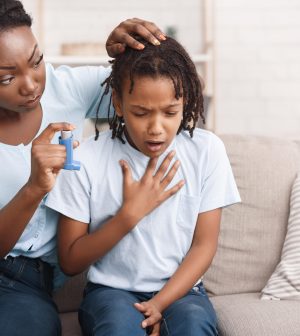- Skip Storing This Everyday Product in the Fridge Door
- Green Tea + B3 Pairing May Boost Brain Health
- Navigating Your Midlife Crisis: Embracing New Possibilities
- City Raccoons Showing Signs of Domestication
- Mapping the Exposome: Science Broadens Focus to Environmental Disease Triggers
- One Week Less on Social Media Linked to Better Mental Health
- Your Brain Changes in Stages as You Age, Study Finds
- Some Suicide Victims Show No Typical Warning Signs, Study Finds
- ByHeart Formula Faces Lawsuits After Babies Sickened With Botulism
- Switch to Vegan Diet Could Cut Your Greenhouse Gas Emissions in Half
Follow-Up Care Can Prevent Repeat ER Visits for Child’s Asthma

After a child shows up in the emergency room in the throes of an asthma attack, follow-up care is the best way to avoid another visit to the hospital down the road.
But when researchers analyzed claims data on more than 90,000 asthma-related emergency department (ED) visits by children ages 3 to 21 in California, Massachusetts and Vermont, they found that only 23% actually received follow-up care, even though guidelines recommend all patients be referred for follow-up within a month of an ED visit for asthma.
“An urgent ED visit for asthma may suggest the child needs daily asthma medications to better control their asthma, or that they are having difficulty avoiding asthma triggers or recognizing symptoms,” said study lead author Dr. Naomi Bardach, a professor of pediatrics at the University of California, San Francisco.
“Follow-up visits are an opportunity to educate the family and child on managing their asthma, prescribe new medications if needed, and ensure success in getting prescribed medications,” Bardach said in a university news release.
Patients who did receive follow-up were younger and more likely to have private insurance, complex chronic health conditions and known asthma from prior ED visits.
Patients were most likely to follow up with a pediatrician (71%), followed by a family doctor (17%), a general internist (9%) and a pulmonologist or immunologist (3%).
But the follow-up care made a difference: Patients who received it within two weeks of an asthma-related ED visit were 12% less likely to return to the ED for asthma within 60 days, and 13% less likely to revisit the hospital for asthma in the next year.
About 5.7% of those with follow-up had a return asthma-related ED visit within 60 days, compared to 6.4% who didn’t have follow-up. After one year, 25% of those with follow-up had a return ED visit compared to 28.3% who had no follow-up.
The study was published online April 1 in the journal Academic Pediatrics.
If follow-up were in place for all asthma-related ED visits, around 72,000 subsequent ED revisits could be prevented and millions of dollars could be saved, according to the researchers.
Asthma is the most common chronic disease in youngsters. It affects 9% of school-aged children and contributes to more than 500,000 ED visits for children annually, according to the U.S. Centers for Disease Control and Prevention.
More information
For more on childhood asthma, go to the American Lung Association.
SOURCE: University of California, San Francisco, news release, March 30, 2022
Source: HealthDay
Copyright © 2025 HealthDay. All rights reserved.










